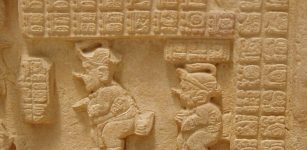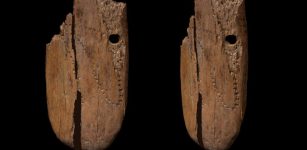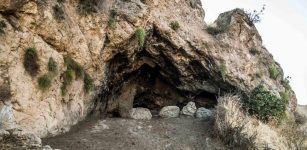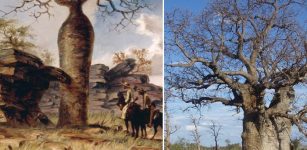Hulagu Khan Destroyed Thousands Of Priceless Ancient Books Kept In The House Of Wisdom In Baghdad
A. Sutherland - AncientPages.com - In the 1200s Baghdad was a prominent and rich ancient city with a high literacy rate. The House of Wisdom was a huge library in Baghdad and a major intellectual center where you could find books and manuscripts about science, art, and Greek literature.
It was a place where scholars came together for dialogue, discussions, and discourses. By the middle of the ninth century, the House of Wisdom had the largest selection of books in the world, but everything was destroyed during the Mongol invasion led by Hulagu Khan.
This incredible ancient library was founded by Caliph Harun al-Rashid (reigned 786–809) and culminated under his son al-Ma'mun (reigned 813–833) who is credited with its formal institution.
The House of Wisdom was in fame, status, scope, size, resources, patronage, etc. similar to that of the present-day British Library in London or the Nationale Bibliotheque in Paris. Not only Muslims but also Christian and Jewish scholars met and studied at the House of Wisdom.
Hulagu Khan, (ca. 1216-1265) who was a Mongol ruler and grandson of Genghis Khan was determined to conquer Mesopotamia.
Genghis Khan did not invade far into the Muslim world, but the Great Khan, Mongke, put his brother Hulagu Khan in charge of an army whose goals were to conquer Mesopotamia, Persia, Syria, and Egypt, as well as to destroy the Abbasid Caliphate. The campaign’s goal appears to be a complete destruction of Islam. Hulagu Khan himself even had a very deep hatred for everything attached to Islam.
Much of his disgust towards Muslims was because of his Buddhist and Christian advisors who influenced his policies.

The House of Wisdom was a huge library in Baghdad and a major intellectual center where you could find books and manuscripts about science, art, and Greek literature.
In the autumn of 1253, Hulagu Khan left Mongolia with a huge army that successfully conquered and destroyed Muslim states in southwestern Asia. His next goal was to conquer the Lurs, Iranian people living mainly in western and south-western Iran of southern Iran, and besiege the Assassins in their primary fortress at Alamut.
The Mongols used all their military power against Alamut, while also offering clemency if the Assassin leader would surrender.
On November 19, 1256, he did so. Hulagu Khan paraded the captured leader in front of all the remaining strongholds and one by one they capitulated. The Mongols tore down the castles at Alamut and other places so that the Assassins could not take refuge and regroup there.
A satisfied Hulagu Khan now focused on Baghdad, a city that he saw as an ultimate trophy.
Hulagu's Mongol army set out for Baghdad in November 1257. The Mongol siege of 1258 AD began in mid-January and lasted just two weeks. On February 13, the Mongols entered the city of the caliphs, commencing a full week of pillage and destruction. Along with all other libraries in Baghdad, the House of Wisdom was destroyed by the army of Hulagu during the Siege of Baghdad.
Thousands of books from Baghdad’s House of Wisdom were thrown into the Tigris River in such quantities that the river ran black with the ink from the books. Nasir al-Din al-Tusi managed to rescue about 400,000 manuscripts which he took to Maragheh before the siege, but the great majority of all precious ancient books and manuscripts kept at the House of Wisdom were gone forever.
Written by – A. Sutherland AncientPages.com Staff Writer
Copyright © AncientPages.com All rights reserved. This material may not be published, broadcast, rewritten or redistributed in whole or part without the express written permission of AncientPages.com
More From Ancient Pages
-
 Legend Of Brigadoon: Mythical Village Where Time Stands Still
Featured Stories | Nov 2, 2016
Legend Of Brigadoon: Mythical Village Where Time Stands Still
Featured Stories | Nov 2, 2016 -
 Rings Of Moray – Sophisticated Irrigation System In Sacred Valley Of The Incas, Peru
Ancient Technology | Sep 11, 2015
Rings Of Moray – Sophisticated Irrigation System In Sacred Valley Of The Incas, Peru
Ancient Technology | Sep 11, 2015 -
 Yam: Tyrannical Hydra-Like Sea Monster God Cast Out Of Heaven
Featured Stories | Aug 3, 2016
Yam: Tyrannical Hydra-Like Sea Monster God Cast Out Of Heaven
Featured Stories | Aug 3, 2016 -
 Oldest Known Human-Made Nanostructures Found In Ancient Artifacts In Tamil Nadu
Ancient Technology | Nov 23, 2020
Oldest Known Human-Made Nanostructures Found In Ancient Artifacts In Tamil Nadu
Ancient Technology | Nov 23, 2020 -
 Alux: Little Mythical Troublemaker And Guardian Of Corn Fields In Mayan Folklore
Featured Stories | Jun 11, 2019
Alux: Little Mythical Troublemaker And Guardian Of Corn Fields In Mayan Folklore
Featured Stories | Jun 11, 2019 -
 Huge Ptolemaic/Roman Funerary Structure Unearthed In Egypt’s Fayoum
Archaeology | Dec 6, 2022
Huge Ptolemaic/Roman Funerary Structure Unearthed In Egypt’s Fayoum
Archaeology | Dec 6, 2022 -
 On This Day In History: Battle Of Dettingen – English Armies Were Victorious Over The French – On June 27, 1743
News | Jun 27, 2016
On This Day In History: Battle Of Dettingen – English Armies Were Victorious Over The French – On June 27, 1743
News | Jun 27, 2016 -
 41,500-Year-Old Ivory Pendant Is The Oldest Evidence Of Humans Decorating Jewelery In Eurasia
Archaeology | Nov 26, 2021
41,500-Year-Old Ivory Pendant Is The Oldest Evidence Of Humans Decorating Jewelery In Eurasia
Archaeology | Nov 26, 2021 -
 Old Unexplained Mystery Of The Frightening Woman On The Isle Of Iona
Featured Stories | Mar 8, 2024
Old Unexplained Mystery Of The Frightening Woman On The Isle Of Iona
Featured Stories | Mar 8, 2024 -
 Ancient Maya Lessons On Surviving Drought – Examined By Scientists
Archaeology | Jan 5, 2022
Ancient Maya Lessons On Surviving Drought – Examined By Scientists
Archaeology | Jan 5, 2022 -
 How And When Did Ancient People Start Using Oil?
Ancient History Facts | Jun 28, 2018
How And When Did Ancient People Start Using Oil?
Ancient History Facts | Jun 28, 2018 -
 Pomegranate-Liked Seeds Found In Ancient Tomb Dated To Han Dynasty
Archaeology | Feb 22, 2017
Pomegranate-Liked Seeds Found In Ancient Tomb Dated To Han Dynasty
Archaeology | Feb 22, 2017 -
 On This Day In History: Astronomer Johannes Kepler Observes Supernova – On Oct 17, 1604
News | Oct 17, 2016
On This Day In History: Astronomer Johannes Kepler Observes Supernova – On Oct 17, 1604
News | Oct 17, 2016 -
 Long-Forgotten Ancient Book Contains Extensive Scientific Survey Of North America Made 4,500 Years Ago
Ancient Mysteries | Jul 26, 2019
Long-Forgotten Ancient Book Contains Extensive Scientific Survey Of North America Made 4,500 Years Ago
Ancient Mysteries | Jul 26, 2019 -
 Ancient History Of The Samurai Armor
Featured Stories | Aug 27, 2018
Ancient History Of The Samurai Armor
Featured Stories | Aug 27, 2018 -
 Artifacts And Remnants Of 3,000-Year-Old City Unearthed Near Great Zab River In Iraqi Kurdistan
Archaeology | Jun 5, 2017
Artifacts And Remnants Of 3,000-Year-Old City Unearthed Near Great Zab River In Iraqi Kurdistan
Archaeology | Jun 5, 2017 -
 What Can Grinding Stones Reveal About Europe’s Earliest Neolithic Communities?
Archaeology | Feb 28, 2025
What Can Grinding Stones Reveal About Europe’s Earliest Neolithic Communities?
Archaeology | Feb 28, 2025 -
 Ancient Indigenous Carvings On Boab Trees – Time To Rescue Ancient Art Before Trees Disappear
Archaeology | Oct 12, 2022
Ancient Indigenous Carvings On Boab Trees – Time To Rescue Ancient Art Before Trees Disappear
Archaeology | Oct 12, 2022 -
 Fulani: Africa’s Pastoralists Traced To Green Sahara Period,12,000 – 5,000 Years Ago
DNA | Feb 26, 2025
Fulani: Africa’s Pastoralists Traced To Green Sahara Period,12,000 – 5,000 Years Ago
DNA | Feb 26, 2025 -
 Medieval Burials Discovered Under London’s Westminster Abbey
News | Sep 24, 2015
Medieval Burials Discovered Under London’s Westminster Abbey
News | Sep 24, 2015



